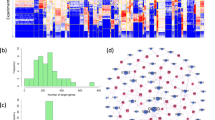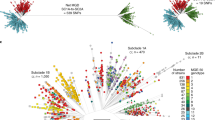Abstract
Publicly available genomic data are a great source of biological knowledge that can be extracted when appropriate data analysis is used. Predicting the biological function of genes is of interest to understand molecular mechanisms of virulence and resistance in pathogens and hosts and is important for drug discovery and disease control. This is commonly done by searching for similar gene expression behavior. Here, we used publicly available Streptococcus pyogenes microarray data obtained during primate infection to identify genes that have a potential influence on virulence and Phytophtora infestance inoculated tomato microarray data to identify genes potentially implicated in resistance processes. This approach goes beyond co-expression analysis. We employed a quasi-likelihood model separated by primate gender/inoculation condition to model median gene expression of known virulence/resistance factors. Based on this model, an influence analysis considering time course measurement was performed to detect genes with atypical expression. This procedure allowed for the detection of genes potentially implicated in the infection process. Finally, we discuss the biological meaning of these results, showing that influence analysis is an efficient and useful alternative for functional gene prediction.
Similar content being viewed by others
References
Bisno A, Brito M, Collins CM (2003) Molecular basis of group A streptococcal virulence. Lancet Infect Dis 3:191–200
Bohach GA, Fast DJ, Nelson RD, Schlievert PM (1990) Staphylococcal and streptococcal pyrogenic toxins involved in toxic shock syndrome and related illnesses. Crit Rev Microbiol 17:251–272
Broudy TB, Pancholi V, Fischetti VA (2002) The in vitro interaction of Streptococcus pyogenes with human pharyngeal cells induces a phage-encoded extracellular. DNase Infect Immun 70:2805–2811
Canchaya C, Fournous G, Chibani-Chennoufi S, Dillmann ML, Brussow H (2003) Phage as agents of lateral gene transfer. Curr Opin Microbiol 6:417–424
Casjens S (2003) Prophages and bacterial genomics: what have we learned so far? Mol Microbiol 49:277–300
Chang JC, LaSarre B, Jimenez JC, Aggarwal C, Federle MJ (2011) Two Group A Streptococcal peptide pheromones act through opposing Rgg regulators to control biofilm development. PLOS Pthogens 7:e1002190
Cox KH, Ruiz-Bustos E, Courtney HS, Dale JB, Pence MA, Nizet V, Aziz RK, Gerling I, Price SM, Hasty DL (2009) Inactivation of DltA modulates virulence factor expression in Streptococcus pyogenes. PloS One 4:e5366
Dubnau D (1999) DNA uptake in bacteria. Annu Rev Microbiol 53:217–244
Edwards JL (2007) Gender differences in Neisseria gonorrhoeae pathogenesis. In: Brogden KA, Minion FC, Cornick N, Stanton TB, Zhang Q, Nolan LK, Wannermuehler MJ (eds) Virulence mechanisms of bacterial pathogens. ASM Press, Washington DC, pp 149–173
Hammill BG, Preisser JS (2006) A SAS/IML software program for GEE and regression diagnostics. Comput Stat Data An 51:1197–1212
Hanley JA, Negassa A, Edwardes MDB, Forrester JE (2003) Statistical analysis of correlated data using generalized estimating equations: an orientation. Am J Epidemiol 157:364–375
Hardin JW, Hilbe J (2003) Generalized estimating equations. Chapman & Hall/CRC, Boca Raton
Hynes WL, Ferretti J (1989) Sequence analysis and expression in Escherichia coli of the hyaluronidase gene of Streptococcus pyogenes bacteriophage H4489A. Infect Immun 57:533–539
Liang KY, Zeger SL (1986) Longitudinal data analysis using generalized linear models. Biometrika 73:13–22
López-Kleine L, Torres-Avilés F, Tejedor F, Gordillo LA (2012) Virulence factor prediction in Streptococcus pyogenes using classification and clustering based on microarray data. AMAB 93:2091–2098
McCullagh P (1983) Quasi likelihood functions. Ann Stat 11:59–67
Nelder JA, Pregibon D (1987) An extended quasi-likelihood function. Biometrika 74:221–232
Pan W (2001) Akaike’s information criterion in generalized estimating equations. Biometrics 57:120–125
Preisser JS, Qaqish BF (1996) Deletion diagnostics for generalised estimating equations. Biometrika 83:551–562
Sagar V, Kumar R, Ganguly NK, Chakraborti A (2008) Comparative analysis of emm type pattern of Group A Streptococcus throat and skin isolates from India and their association with closely related SIC, a streptococcal virulence factor. BMC Microbiol 8:150
SAS Institute Inc (2008) Whats New in SAS 9.2. SAS Institute Inc., Cary
Segal MR, Dahlquist KD, Conklin BR (2003) Regression approaches for microarray data analysis. J Comput Biol 10:961–980
Shelburne SA, Keith D, Horstmann N, Sumby P, Davenport MT, Graviss EA, Brennan RG, Musser JM (2008) A direct link between carbohydrate utilization and virulence in the major human pathogen group A Streptococcus. Proc Natl Acad Sci USA 105:1698–1703
Siboo IR, Bensing BA, Sullam PM (2003) Genomic organization and molecular characterization of SM1, a temperate bacteriophage of Streptococcus mitis. J Bacteriol 185:6968–6975
Virtaneva K, Porcella SF, Graham MR, Ireland RM, Johnson CA, Ricklefs SM, Babar I, Parkins LD, Romero RA, Corn GJ, Gardner DJ, Bailey JR, Parnell MJ, Musser JM (2005) Longitudinal analysis of the group A Streptococcus transcriptome in experimental pharyngitis in cynomolgus macaques. PNAS 102:9014–9019
Wedderburn R (1974) Quasi-likelihood functions, generalized linear models, and the Gauss-Newton methods. Biometrika 61:439–447
Williams DA (1987) Generalized linear model diagnostics using the deviance and single case deletions. Appl Stat 36:181–191
Ziegler A, Blettner M, Kastner C, Chang-Claude J (1998) Identifying influential families using regression diagnostics for generalized estimating equations. Genet Epidemiol 15:341–353
Author information
Authors and Affiliations
Corresponding author
Additional information
Communicated by M. Hecker.
Rights and permissions
About this article
Cite this article
Romeo, J.S., Torres-Avilés, F. & López-Kleine, L. Detection of influent virulence and resistance genes in microarray data through quasi likelihood modeling. Mol Genet Genomics 288, 49–61 (2013). https://doi.org/10.1007/s00438-012-0730-8
Received:
Accepted:
Published:
Issue Date:
DOI: https://doi.org/10.1007/s00438-012-0730-8




